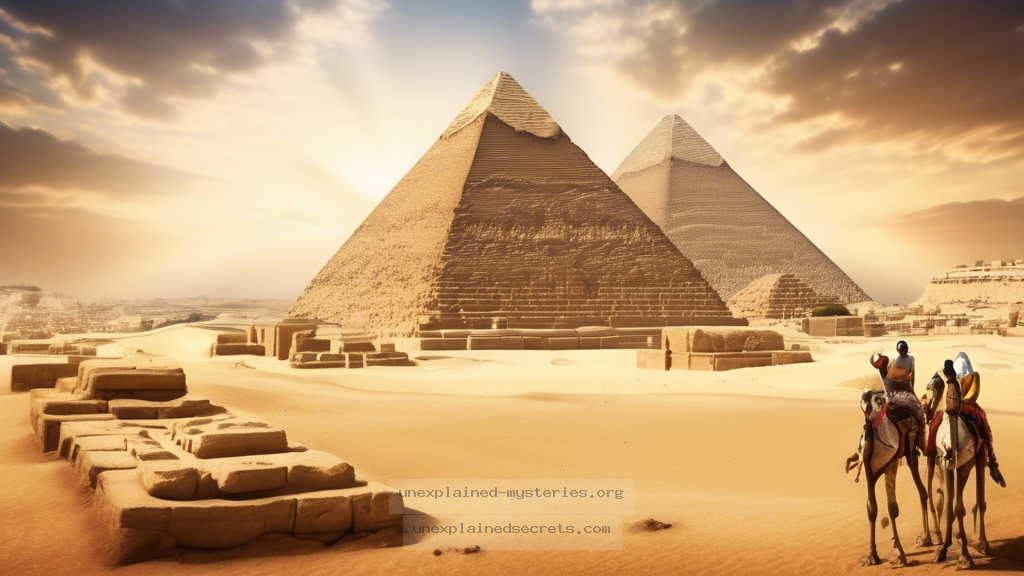What Secrets Lie Beneath the Pyramids of Giza? Unraveling the Mysteries of Ancient Egypt’s Most Iconic Structures
What Secrets Lie Beneath the Pyramids of Giza? Unraveling the Mysteries of Ancient Egypt’s Most Iconic Structures
The Pyramids of Giza stand as monumental testaments to human ingenuity and ambition, yet they are also shrouded in an aura of mystery that has captivated historians, archaeologists, and the public alike for centuries. What secrets do these ancient structures hold? How were they constructed with such precision and purpose? As we delve into the mysteries of Giza, we confront questions that challenge our understanding of ancient civilizations, their capabilities, and their knowledge.
Historical Context: The Era of the Pharaohs
The Pyramids of Giza were built during the Fourth Dynasty of the Old Kingdom of Egypt, around 2580 – 2560 BCE, primarily as tombs for pharaohs. The three main pyramids—Khufu (Cheops), Khafre (Chephren), and Menkaure (Mykerinos)—were part of a larger complex that included temples and smaller pyramids for queens. The Great Pyramid of Khufu, in particular, is the largest and most renowned, originally standing at 146.6 meters (481 feet) tall and composed of an estimated 2.3 million blocks of stone.
This era marked significant advancements in engineering, mathematics, and astronomy, reflecting the Egyptians’ belief in the afterlife and their desire to ensure a safe passage for their rulers. However, the techniques and tools they employed remain largely speculative, leading to ongoing debates among scholars.
Construction Techniques: How Were They Built?
The construction of the pyramids has been a topic of fascination and debate for centuries. Traditional theories suggest that the blocks were quarried from nearby sites and transported to Giza using sleds and rolling logs. Others speculate that a system of ramps was employed to elevate the stones as the structure grew taller. However, the exact methods continue to elude definitive explanation.
Recent studies have proposed innovative theories, including the use of a spiral ramp that encircled the pyramid as it was built, allowing workers to move stones without the need for complex machinery. Despite these theories, no conclusive evidence has been uncovered to definitively explain how the ancient Egyptians achieved such precision and scale in their constructions.
Core Concepts: The Purpose of the Pyramids
Understanding the purpose of the pyramids is crucial to deciphering their mysteries. They were not merely tombs; they represented a culmination of religious beliefs, political power, and architectural prowess. The pyramids were designed to facilitate the pharaoh’s journey to the afterlife, symbolizing the connection between the physical and spiritual worlds.
The elaborate burial rites and complex hieroglyphs found within the pyramids emphasize the Egyptians’ belief in immortality and the soul’s journey after death. Moreover, the pyramids served as a statement of the pharaoh’s divine right to rule, reinforcing the social hierarchy of the time.
Archaeological Discoveries: What Have We Found?
Over the years, numerous archaeological expeditions have uncovered artifacts and structures that provide insights into the lives of those who built the pyramids. From tools and burial goods to graffiti left by workers, these discoveries have shaped our understanding of ancient Egyptian society.
One significant find is the workers’ village, discovered in the 1990s, which revealed that the laborers who built the pyramids were not slaves but rather skilled workers who lived in organized communities. Evidence of their diet, health, and living conditions has provided a glimpse into the daily life of those who contributed to these monumental constructions.
| Discovery | Significance |
|---|---|
| Workers’ Village | Revealed that laborers were skilled workers, not slaves |
| Graffiti | Provided insights into the organization and morale of the workers |
| Tools and Artifacts | Indicated the methods and technologies used in construction |
Unsolved Mysteries: What Remains Unknown?
Despite extensive research, several mysteries surrounding the Pyramids of Giza remain unsolved. One of the most significant is the precise number of workers involved in the construction. Estimates range from tens of thousands to just a few thousand, but the lack of concrete evidence leaves this question open to interpretation.
Additionally, the pyramid’s internal layout, including the purpose of certain chambers and shafts, continues to puzzle archaeologists. For example, the Grand Gallery and the so-called “Queen’s Chamber” do not fit traditional burial practices, leading to theories about their alternative functions, such as astronomical observatories or storage for sacred artifacts.
Alternative Perspectives: Theories Beyond Conventional Wisdom
Beyond mainstream archaeological theories, alternative perspectives have emerged, suggesting that the pyramids could be evidence of lost advanced civilizations or even extraterrestrial influence. Proponents of these theories argue that the precision and scale of the pyramids are beyond the capabilities of ancient humans, citing the alignment of the pyramids with celestial bodies as potential proof of advanced knowledge.
While these theories are often met with skepticism from the academic community, they reflect the enduring allure of the pyramids and the human desire to uncover the unknown. Such perspectives challenge conventional thinking and encourage ongoing exploration and inquiry.
Common Misconceptions: Debunking Myths
Several myths surrounding the Pyramids of Giza have persisted over time, often perpetuated by sensationalized media or misinterpretations of historical facts. One common misconception is that the pyramids were built by slaves. As mentioned earlier, evidence suggests that a workforce comprised of skilled laborers was responsible for their construction, dispelling this long-held belief.
Another myth is that the pyramids were constructed in a short time frame. In reality, the construction of the Great Pyramid likely took over two decades, involving careful planning, labor organization, and resource management.
Best Practices for Investigation: How to Approach the Study of the Pyramids
Investigating the mysteries of the Pyramids of Giza requires a multidisciplinary approach that combines archaeology, history, engineering, and even astronomy. Researchers should consider the following best practices when studying these ancient structures:
- Utilize modern technology, such as ground-penetrating radar, to uncover hidden chambers.
- Engage in interdisciplinary collaboration to gain diverse perspectives on construction techniques.
- Preserve the site while conducting research to prevent damage to these invaluable structures.
- Incorporate historical texts and records to contextualize findings within the broader narrative of ancient Egypt.
Future Developments: What Lies Ahead in Pyramid Research?
The future of research into the Pyramids of Giza is promising, with technological advancements paving the way for new discoveries. Non-invasive techniques, such as 3D scanning and imaging, are set to revolutionize our understanding of these ancient wonders. Ongoing excavations and studies aim to explore the surrounding areas for additional clues about the lives of those who built the pyramids.
Moreover, as global interest in ancient Egypt continues to rise, collaborative efforts between institutions worldwide may lead to more comprehensive studies, shedding light on the mysteries that remain. The integration of traditional archaeological methods with modern technology holds the potential to unlock secrets that have eluded us for millennia.
Conclusion: The Enduring Mystique of the Pyramids
The Pyramids of Giza remain a captivating mystery, embodying the ingenuity and ambition of ancient Egyptians. While we have made significant strides in understanding their construction, purpose, and cultural significance, many questions linger unanswered. The interplay of historical context, archaeological discoveries, and alternative theories enriches our exploration of these iconic structures.
As we continue to unravel the mysteries of the pyramids, we are reminded of the enduring allure of ancient civilizations and the complexities of their achievements. The quest for knowledge is ongoing, and with each discovery, we draw closer to understanding the secrets that lie beneath the sands of Giza.
Other Articles
Recent Posts
- What Happened to Flight MH370? The Conspiracy Theories That Still Haunt Us
- What Secrets Lurk Within the Walls of the Infamous Trans-Allegheny Lunatic Asylum?
- What Evidence Supports the Existence of Bigfoot in the Pacific Northwest?
- What Happened to the Indus Valley Civilization? Unraveling the Mysteries of Ancient Urban Life
- Can Telepathy Be Scientifically Proven Through Laboratory Evidence?







